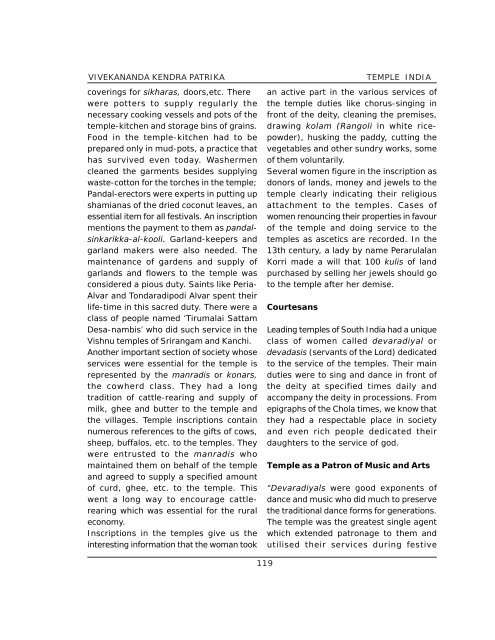Temples In India-1.pdf - Vivekananda Kendra Prakashan
Temples In India-1.pdf - Vivekananda Kendra Prakashan
Temples In India-1.pdf - Vivekananda Kendra Prakashan
Create successful ePaper yourself
Turn your PDF publications into a flip-book with our unique Google optimized e-Paper software.
VIVEKANANDA KENDRA PATRIKAcoverings for sikharas, doors,etc. Therewere potters to supply regularly thenecessary cooking vessels and pots of thetemple-kitchen and storage bins of grains.Food in the temple-kitchen had to beprepared only in mud-pots, a practice thathas survived even today. Washermencleaned the garments besides supplyingwaste-cotton for the torches in the temple;Pandal-erectors were experts in putting upshamianas of the dried coconut leaves, anessential item for all festivals. An inscriptionmentions the payment to them as pandalsinkarikka-al-kooli.Garland-keepers andgarland makers were also needed. Themaintenance of gardens and supply ofgarlands and flowers to the temple wasconsidered a pious duty. Saints like Peria-Alvar and Tondaradipodi Alvar spent theirlife-time in this sacred duty. There were aclass of people named ‘Tirumalai SattamDesa-nambis’ who did such service in theVishnu temples of Srirangam and Kanchi.Another important section of society whoseservices were essential for the temple isrepresented by the manradis or konars,the cowherd class. They had a longtradition of cattle-rearing and supply ofmilk, ghee and butter to the temple andthe villages. Temple inscriptions containnumerous references to the gifts of cows,sheep, buffalos, etc. to the temples. Theywere entrusted to the manradis whomaintained them on behalf of the templeand agreed to supply a specified amountof curd, ghee, etc. to the temple. Thiswent a long way to encourage cattlerearingwhich was essential for the ruraleconomy.<strong>In</strong>scriptions in the temples give us theinteresting information that the woman tookTEMPLE INDIAan active part in the various services ofthe temple duties like chorus-singing infront of the deity, cleaning the premises,drawing kolam (Rangoli in white ricepowder),husking the paddy, cutting thevegetables and other sundry works, someof them voluntarily.Several women figure in the inscription asdonors of lands, money and jewels to thetemple clearly indicating their religiousattachment to the temples. Cases ofwomen renouncing their properties in favourof the temple and doing service to thetemples as ascetics are recorded. <strong>In</strong> the13th century, a lady by name PerarulalanKorri made a will that 100 kulis of landpurchased by selling her jewels should goto the temple after her demise.CourtesansLeading temples of South <strong>In</strong>dia had a uniqueclass of women called devaradiyal ordevadasis (servants of the Lord) dedicatedto the service of the temples. Their mainduties were to sing and dance in front ofthe deity at specified times daily andaccompany the deity in processions. Fromepigraphs of the Chola times, we know thatthey had a respectable place in societyand even rich people dedicated theirdaughters to the service of god.Temple as a Patron of Music and Arts“Devaradiyals were good exponents ofdance and music who did much to preservethe traditional dance forms for generations.The temple was the greatest single agentwhich extended patronage to them andutilised their services during festive119
















